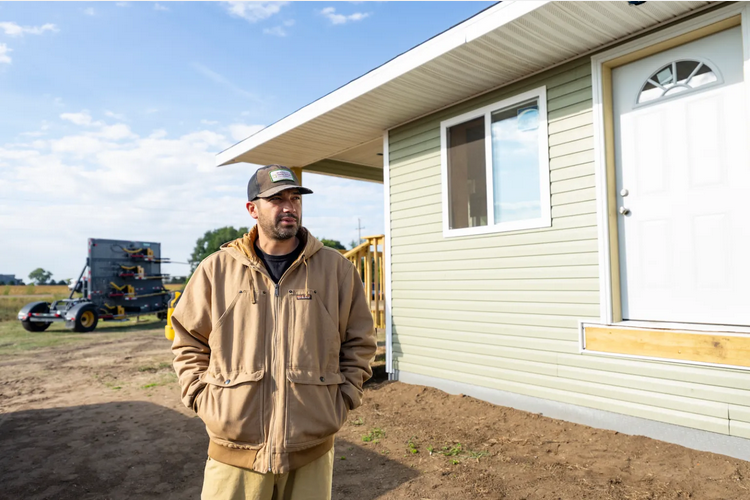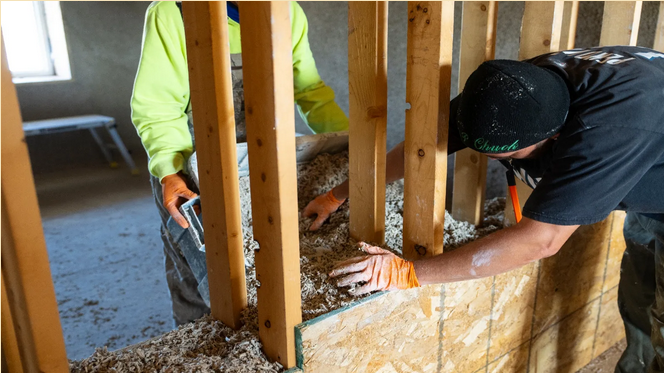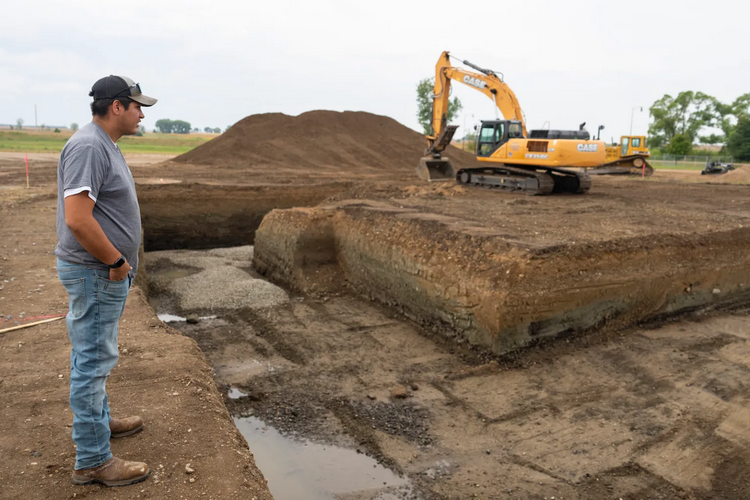Natives from the Lower Sioux Indian Reservation in southwestern Minnesota are building a 20,000-square-foot manufacturing campus that will allow them to pioneer a green experiment, the first of its kind in the United States. They are growing hemp to process it into hempcrete, and then build healthy homes with it.
Once the tribe makes this low-carbon material, they can begin to address a severe shortage of housing and jobs. Recapturing a slice of sovereignty would be a win for them, since they were subjected to some of the worst brutality against the Indigenous nations in North America. Nearly half of the 1,124 enrolled members of the tribe need homes.
 Now, they have two prototypes that are nearly done. While learning how to make these, the construction team developed a skill they can market off the reservation as well. “The idea of making homes that would last and be healthy was a no-brainer,” said Robert Larsen, the tribal council president. “We need to build capacity in the community and show that it can be an income stream.” Virtually no one in the community had experience with either farming or construction before the five-person team was assembled earlier this year.
Now, they have two prototypes that are nearly done. While learning how to make these, the construction team developed a skill they can market off the reservation as well. “The idea of making homes that would last and be healthy was a no-brainer,” said Robert Larsen, the tribal council president. “We need to build capacity in the community and show that it can be an income stream.” Virtually no one in the community had experience with either farming or construction before the five-person team was assembled earlier this year.
Hempcrete is normally the domain of rich people with means to contract a green home, not marginalized communities. That’s because the sustainable material is normally imported from Europe rather than made locally.
 The project is the brainchild of Earl Pendleton, 52, a rail-thin man of quiet intensity, who until recently was the tribal council’s vice president. He grew obsessed with industrial hemp when reading about it 13 years ago. Pendleton was intrigued to learn that the bamboo-like plant has 25,000 uses, including wood substitutes, biofuel, bioplastics, animal feed, and textiles.
The project is the brainchild of Earl Pendleton, 52, a rail-thin man of quiet intensity, who until recently was the tribal council’s vice president. He grew obsessed with industrial hemp when reading about it 13 years ago. Pendleton was intrigued to learn that the bamboo-like plant has 25,000 uses, including wood substitutes, biofuel, bioplastics, animal feed, and textiles.
 Hemp can grow in a variety of climates and, depending on the location, can yield more than one harvest a year. What’s more, hemp regenerates soil, sequesters carbon, and doesn’t require fertilizers.
Hemp can grow in a variety of climates and, depending on the location, can yield more than one harvest a year. What’s more, hemp regenerates soil, sequesters carbon, and doesn’t require fertilizers.
 Hempcrete is made by mixing mashed stalks with lime and water. The resulting oatmeal-like substance is stuffed or sprayed into the cavities of framed walls. Once it hardens, it resembles concrete to the touch but has different properties. The cured substance has airtight qualities that can dramatically cut down on heating and air-conditioning needs. Unlike many commonly used building materials, it is nontoxic and resists mold, fire, and pests.
Hempcrete is made by mixing mashed stalks with lime and water. The resulting oatmeal-like substance is stuffed or sprayed into the cavities of framed walls. Once it hardens, it resembles concrete to the touch but has different properties. The cured substance has airtight qualities that can dramatically cut down on heating and air-conditioning needs. Unlike many commonly used building materials, it is nontoxic and resists mold, fire, and pests.
Commercial hemp was banned in the U.S. until the 2018 Farm Bill , but hempcrete has been slow to catch on. Farmers don’t want to plant without facilities nearby to process the stalks. Potential processors don’t want to buy expensive machinery without guarantees of raw material. And most American contractors don’t know anything about hempcrete.
Once the tribal council got on board three years ago, they cobbled together loans, government grants, and their own funds to earmark more than $6 million to build the first two prototype homes and the processing campus.
They have the potential to plant hemp on 300 acres and, at a given time, grow on between 100 and 200 acres.
 The processing campus where they hope to manufacture blocks or panels of hempcrete has a solar greenhouse to store bags of lime and hemp, as well as equipment such as a combine harvester and a decorticator that separates the hurd from the softer fibers that can be used for textiles.
The processing campus where they hope to manufacture blocks or panels of hempcrete has a solar greenhouse to store bags of lime and hemp, as well as equipment such as a combine harvester and a decorticator that separates the hurd from the softer fibers that can be used for textiles.
Native American tribes have an advantage, because they can build with materials that are new, without having to get them certified by a national agency. They don’t have the bureaucracy holding them down.
You can read the original article at grist.org

LOVING this concept! All the experimentation with hempcrete is promising and another reason the stupid War on Drugs should be ditched!
I’m very grateful for this article – it has sent me on a research journey that I expect will keep going. Below are my thoughts on how to use hemp to address plugging abandoned oil wells. I got the idea after watching a YouTube video of a hemp fiber processing facility in Montana and a comment about one of their customers. This builds on that concept.
Thoughts/strategy that I posted to the Climate Pilots team on Kiva.
“Have some thinking on the orphaned well mess and will see about hitting up some California politicians and nature and others groups to see how to bring to fruition (would be a green job/business creator as well as working on the orphaned oil wells and also beginning to clean up the soil in the oil fields.)
– sow hemp in the fields with orphaned wells (hemp has short grow cycle and low maintenance needs)
– while hemp is growing set up mobile hemp fiber processing facility as well as hempcrete processing unit
– harvest hemp and cure
– make hempcrete and plug wells
– then decide what good future use there is for the land”
Glad to see my tax dollars helping